"Island in the Valley"
(print this out and take it with you on your next visit to Burritts Rapids)
Created by Pat Stroulger
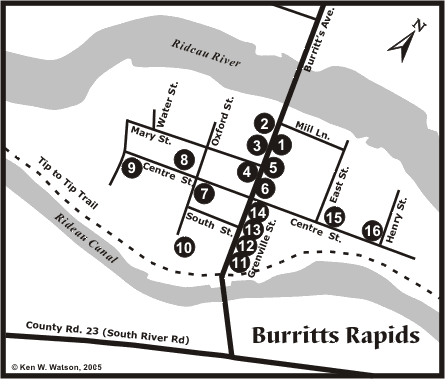 |
Name of Stop
1 = Community Hall
2 = John S. French House
3 = 'Riverview'
4 = Stephen Hurd House
5 = Erastus Harris House
6 = John Healey Grocery
7 = George/Edgar Burritt
8 = John Muir House
9 = Log House
10 = Orange Masonic Hall
11 = Original Bridgemaster House
12 = Patrick McGowan House
13 = Shoe Shop
14 = Hugh Conn House
15 = Old Methodist Church
16 = Richard Guest House
|
Stephen Burritt with his wife Martha (Stephens) and brothers Daniel and Edmund came to this area in early 1793. He was granted land in the hamlet now known as Burritts Rapids and with the construction of the canal in 1827-1831 the land was "sub-divided" and subsequently the "island" became the heart of a thriving community. By the mid-19th century the hamlet boasted several mills, a tailor shop, hat shop, two shoe stores, a bank, post office, two hotels and even a resident doctor. Unfortunately, once river traffic was superceded by the railroad, which by-passed the community, commerce declined and the hamlet was left in peace. Old photos show Grenville St. has not changed too much in 200 or so years - the shops have gone, but the structures have been carefully retained as private homes.
The tour will take approximately 30 minutes at a leisurely stroll, add an additional 60 minutes for the “Tip to Tip Trail” (2 km nature walk)
* Denotes designated heritage building/site.
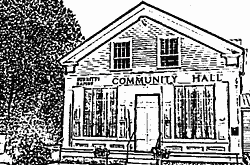 Stop 1 - 23 Grenville St.* - The Community Hall was built in 1840 by John Strahan French as a general store with living quarters above. Typical neo-classical with gable end facing the road. In 1902, the building was bought by the trustees of the Methodist Church for Church functions. In 1935 it was purchased by a group of residents and is still today owned and operated by the residents of the village. In order to maintain the building, it is rented out to various organizations and for private functions. Note the plaque on the building and the Ontario Historic Sign beside the Community Hall building. Looking across the street to.... Stop 1 - 23 Grenville St.* - The Community Hall was built in 1840 by John Strahan French as a general store with living quarters above. Typical neo-classical with gable end facing the road. In 1902, the building was bought by the trustees of the Methodist Church for Church functions. In 1935 it was purchased by a group of residents and is still today owned and operated by the residents of the village. In order to maintain the building, it is rented out to various organizations and for private functions. Note the plaque on the building and the Ontario Historic Sign beside the Community Hall building. Looking across the street to....
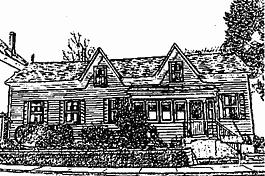
Stop 2 - 24 Grenville St. - In 1841, J.S. French, his wife and 5 children lived here. The stone building on blacksmith shop and was known as French’s Forge. A sawmill was also located on the riverbank at one time and he operated a gristmill across the road.
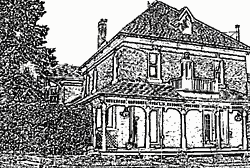
Stop 3 - 22 Grenville St. - Built in 1895, to replace a frame building, by Thomas Kidd and called Riverview. Constructed of stretched bond brick with bracketed eaves, keystones on the exposed sides of the house decorated with terra cotta heads. Also boasts an elaborate verandah.
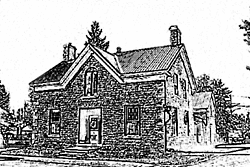
Stop 4 - 16 Grenville St. - Built by Stephen Hurd, c. 1851, son of Ashael Hurd and Sarah (Burritt). Late neo-classical style, medium pitch roof, semi-circular headed window, large panes and square transomed doorway. There was originally a verandah attached topped by a recessed balcony. Across the street....
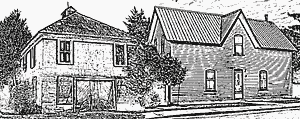 Stop 5 - 17 Grenville St. - Bought by Erastus Harris, a blacksmith, in the 1850s. A steeper roof line and segmental headed doors and windows leads one to believe it was probably re-built about 1873. Next to the house is the red pressed metal building which contains an intact forge last used in the 1940s. The forge was probably built around 1860. Stop 5 - 17 Grenville St. - Bought by Erastus Harris, a blacksmith, in the 1850s. A steeper roof line and segmental headed doors and windows leads one to believe it was probably re-built about 1873. Next to the house is the red pressed metal building which contains an intact forge last used in the 1940s. The forge was probably built around 1860.
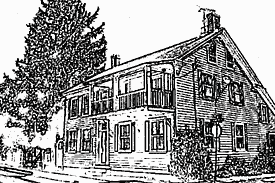
Stop 6 - 15 Grenville St. - John Healey bought this lot from Henry Burritt in 1852. In 1853, tax assessment rolls show J. Haley listed as owning a grocery business here which he sold to Hamlet Burritt in 1875. Like most of the commercial buildings it was converted to a private home. Continue West on Centre Street...
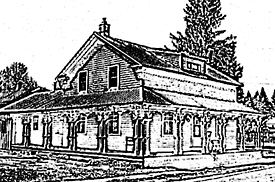
Stop 7 - 14 Centre St. - Typical 1 ½ storey mid-19th century building probably erected by George Burritt or his brother Edgar who was a carpenter. The elaborate treillage is a later addition. The house has been owned by the same family since 1922.
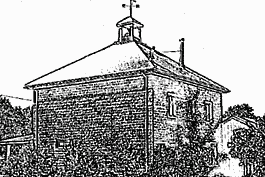
Stop 8 - 11 Centre St. - John Muir bought this property in 1859 and erected a home. Later he either sold or donated the building to replace the old log school house in the village. This school operated until 1964 and the building was sold and converted back to a private home.
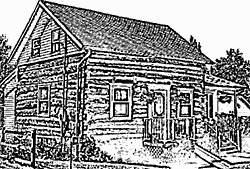
Stop 9 - 8 Centre St. - Original log house. Probably moved from another location in circa 1861. The siding covered portion is a newer addition. Continue East to re-join Oxford Street.
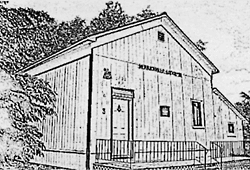
Stop 10 - 3 Oxford St. - Thomas Johnson, an Irishman of Loyalist persuasion donated this land in 1857 to build an Orange Masonic Lodge. Walk through the opening at the south end of the building and go right, this is one of the entry points to the "Tip to Tip" trail. Include this in your walk OR return to Grenville St. to continue the historic home tour... (more information on the trail is at the end of this brochure)

Stop 11 - 1 Grenville St.* and Swing Bridge - Parks Canada Heritage designated building c.1920 housed the Bridgemaster, now the local branch of the North Grenville Public Library. Note the Plaque on the building and the 1897 hand operated swing bridge. Historically, 3 blasts on a boats whistle was the signal to open the bridge.
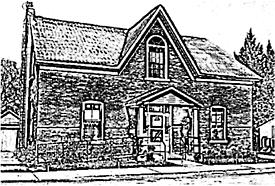
Stop 12 - 3 Grenville St. – In 1857, Patrick McGowan, the Bridgemaster lived here. A 1 ½ storey brick building (Note: the two southern corners are not at right angles). The roof’s steeper pitch and segmental headed windows suggests a later style than most of the other houses nearby.
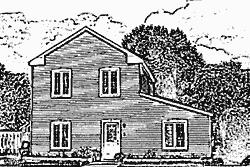
Stop 13 - 5 Grenville St. - Built around 1850 and used as a shoe shop. The construction is post and beam. Over the years, it has housed various stores, tea room etc. It is now restored as a private home.
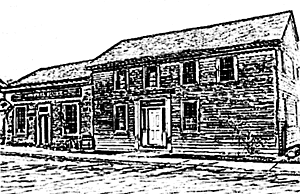
Stop 14 - 7 Grenville St. – Neo-classical in design and a rather handsome barge board home. Probably built by Hugh Conn in the late 1800s. Attached to it is a stone building which over the years has operated a variety of commercial enterprises. In 1912 it housed the Union Bank …. Enjoy, have an ice cream cone or coffee. Go East on Centre Street ….
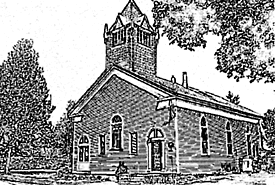
Stop 15 - 25 Centre St. – The old Methodist Church, later a United Church was consecrated in 1855 and served as a place of worship for over 120 years. The bell and tower were erected in 1899. It was closed in 1974 and turned into a private home.
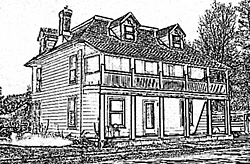 Stop 16 - 27 Centre Street – Built by Richard Guest in c.1872 who owned a tannery and a cheese factory located on Henry Street, both have long since disappeared. Across the street is another access to the the “Tip to Tip” trail which takes you to the Rideau Canal Lock Station #17 along a pleasant path bordering the Rideau Canal. From the locks you can return via the same path or cross over the lock gates and walk back via the road (~1 km). Refreshments and washrooms are available at the only restaurant in the area. Stop 16 - 27 Centre Street – Built by Richard Guest in c.1872 who owned a tannery and a cheese factory located on Henry Street, both have long since disappeared. Across the street is another access to the the “Tip to Tip” trail which takes you to the Rideau Canal Lock Station #17 along a pleasant path bordering the Rideau Canal. From the locks you can return via the same path or cross over the lock gates and walk back via the road (~1 km). Refreshments and washrooms are available at the only restaurant in the area.
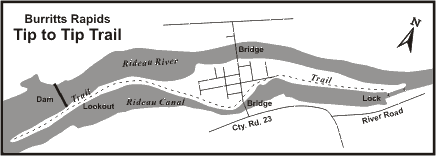
Tip to Tip Trail
The island was created by the construction of the Rideau Canal. A dam was built upstream to bypass rapids and a channel excavated around the rough water. The 2 km trail leads past cool cedar forests, muskrat marshes, a beech nut grove and the pine covered upstream tip. You are walking on a soil ridge built by man 175 years ago. The embankment holds the canal channel water 15 feet above the river, just visible through the trees. The work involved in accomplishing such a task with shovels and wheelbarrows is difficult for a modern mind to grasp. The task was dangerous as well, with the twin hazards of malaria and gun powder claiming many lives.
A brochure detailing this trail is available at the Burritts Rapids lockstation. The brochure can also be downloaded from this website by going to the Documents Page.
Acknowledgements
I would like to thank Olivia Mills for her personal help with this guide (2005) and acknowledge the reference material used: Burritt's Rapids 1793-1993 A Scrapbook, and the Parks Canada Brochure (1979) Tip to Tip Trail.
Sincerely, Pat Stroulger
The book "Burritt's Rapids 1793-1993 A
Scrapbook" had its 2nd printing in 2005 and is available for purchase from Inga VanGemeren, Burritts Rapids Community Hall Corporation (613) 269-2850
©2005 P. Stroulger
Text from 2005 version of the brochure.
Web version created in 2005 by Ken W. Watson.
|